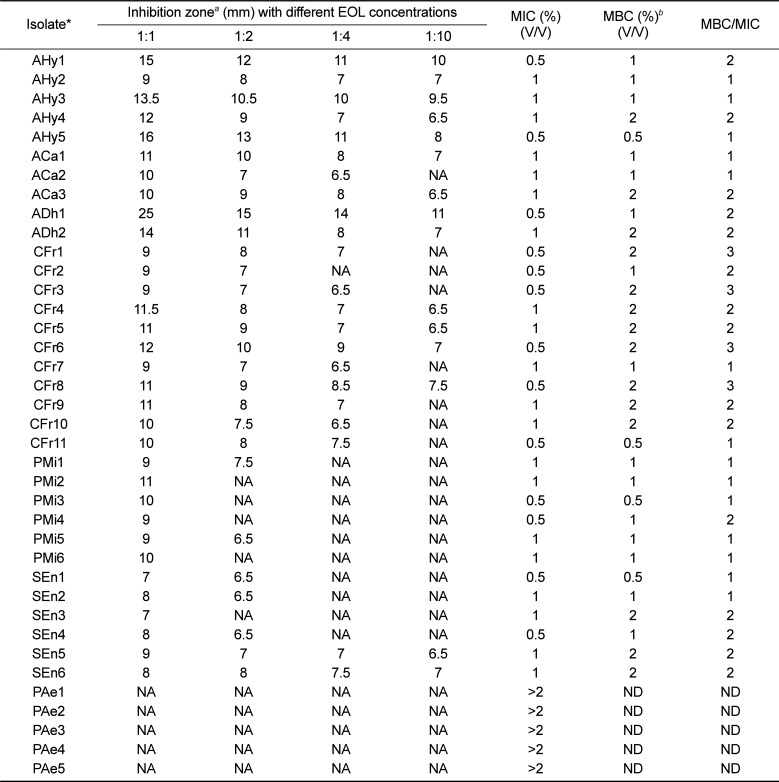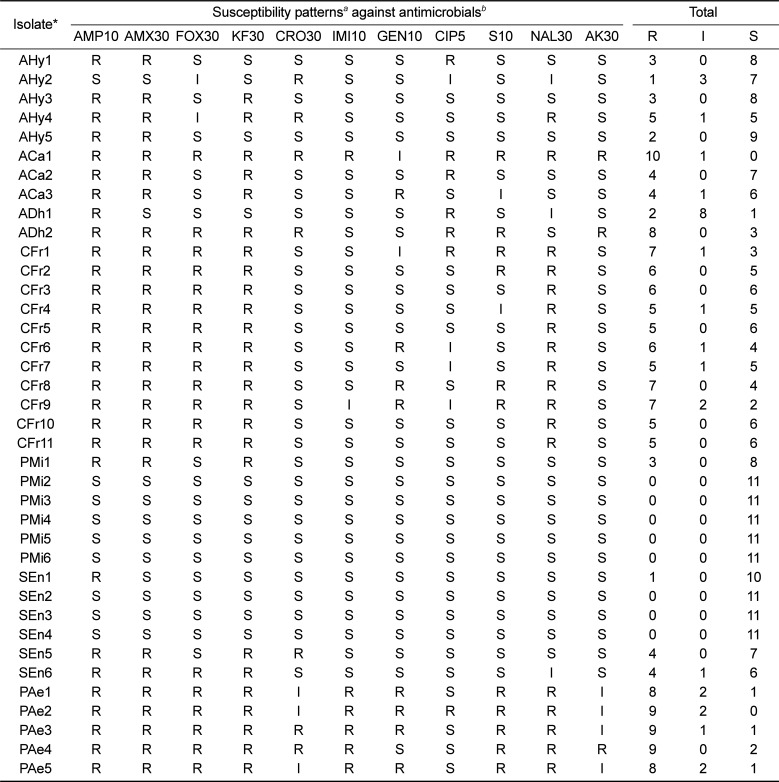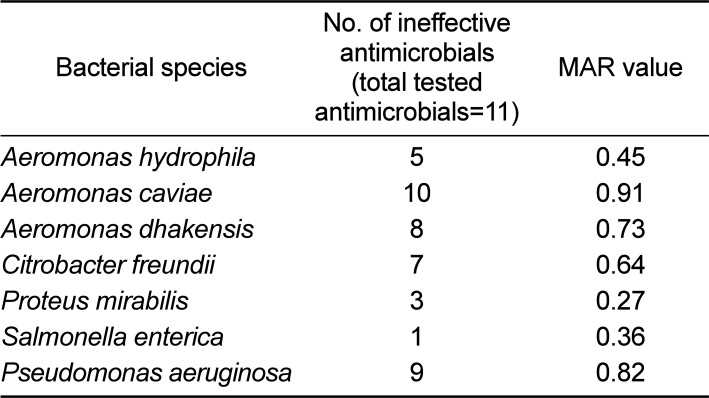1. Schelz Z, Molnar J, Hohmann J. Antimicrobial and antiplasmid activities of essential oils. Fitoterapia. 2006; 77(4):279–285. PMID:
16690225.

2. Prabuseenivasan S, Jayakumar M, Ignacimuthu S.
In vitro antibacterial activity of some plant essential oils. BMC Complement Altern Med. 2006; 6:39. PMID:
17134518.

3. O'Bryan CA, Pendleton SJ, Crandall PG, Ricke SC. Potential of Plant Essential Oils and Their Components in Animal Agriculture-in vitro Studies on Antibacterial Mode of Action. Front Vet Sci. 2015; 2:35. PMID:
26664964.
4. Cavanagh HMA, Wilkinson JM. Lavender essential oil: A review. Aust Infect Control. 2005; 10(1):35–37.

5. Sienkiewicz M, Głowacka A, Kowalczyk E, Wiktorowska-Owczarek A, Jóźwiak-Bębenista M, Łysakowska M. The biological activities of cinnamon, geranium and lavender essential oils. Molecules. 2014; 19(12):20929–20940. PMID:
25514231.

6. Cavanagh HM, Wilkinson JM. iological activities of lavender essential oil. Phytother Res. 2002; 16(4):301–308. PMID:
12112282.
7. Lis-Balchin M, Hart S. Studies on the mode of action of the essential oil of lavender (Lavandula angustifolia P. Miller). Phytother Res. 1999; 13(6):540–542. PMID:
10479772.
8. Soković M, Glamoèlija J, Marin PD, Brkiæ D, van Griensven LJ. Antibacterial effects of the essential oils of commonly consumed medicinal herbs using an in vitro model. Molecules. 2010; 15(11):7532–7546. PMID:
21030907.

9. Inouye S, Takizawa T, Yamaguchi H. Antibacterial activity of essential oils and their major constituents against respiratory tract pathogens by gaseous contact. J Antimicrob Chemother. 2001; 47(5):565–573. PMID:
11328766.

10. Nelson RR. In-vitro activities of five plant essential oils against methicillin-resistant Staphylococcus aureus and vancomycin-resistant Enterococcus faecium. J Antimicrob Chemother. 1997; 40(2):305–306. PMID:
9302003.
11. Back DS, Shin GW, Wendt M, Heo GJ. evalence of Salmonella spp. in pet turtles and their environment. Lab Anim Res. 2016; 32(3):166–170. PMID:
27729933.
12. Hossain S, Wimalasena SHMP, De Zoysa M, Heo G-J. Prevalence of Citrobacter spp. from pet turtles and their environment. J Exot Pet Med. 2017; 26(1):7–12.
13. Wendt M, Heo GJ. Multilocus sequence typing analysis of Pseudomonas aeruginosa isolated from pet Chinese stripe-necked turtles (Ocadia sinensis). Lab Anim Res. 2016; 32(4):208–216. PMID:
28053614.
14. Díaz MA, Cooper RK, Cloeckaert A, Siebeling RJ. Plasmid-mediated high-level gentamicin resistance among enteric bacteria isolated from pet turtles in Louisiana. Appl Environ Microbiol. 2006; 72(1):306–312. PMID:
16391058.

15. De Silva BCJ, Wimalasena SHMP, Hossain S, Pathirana HNKS, Heo G-J. Characterization of quinolone resistance of Pseudomonas aeruginosa isolated from pet Chinese stripe-necked turtles (Ocadia sinensis). Asian J Anim Vet Adv. 2017; 12(3):152–160.
16. Hossain S, Wimalasena SHMP, Heo G-J. Virulence factors and antimicrobial resistance pattern of Citrobacter freundii isolated from healthy pet turtles and their environment. Asian J Anim Vet Adv. 2017; 12(1):10–16.
17. Shelton, The animal desk reference. CreateSpace Independent Publishing Platform;2012. p. 318–420.
18. CLSI. Performance standards for antimicrobial susceptibility testing: Twenty-fourth informational supplement: CLSI M100-S24. Wayne, USA: Clinical and Laboratory Standards Institute (CLSI);2014.
19. Fournomiti M, Kimbaris A, Mantzourani I, Plessas S, Theodoridou I, Papaemmanouil V, Kapsiotis I, Panopoulou M, Stavropoulou E, Bezirtzoglou EE, Alexopoulos A. Antimicrobial activity of essential oils of cultivated oregano (Origanum vulgare), sage (Salvia officinalis), and thyme (Thymus vulgaris) against clinical isolates of Escherichia coli, Klebsiella oxytoca, and Klebsiella pneumoniae. Microb Ecol Health Dis. 2015; 26:23289. PMID:
25881620.

20. Park JW, Wendt M, Heo GJ. Antimicrobial activity of essential oil of Eucalyptus globulus against fish pathogenic bacteria. Lab Anim Res. 2016; 32(2):87–90. PMID:
27382376.
21. Shehata SA, Mohamed MS, El-Shafi SA. Antibacterial activity of essential oils and their effects on Nile tilapia fingerlings performance. J Med Sci. 2013; 13(5):367–372.

22. Lis-Balchin M. Lavender: the genus Lavandula. London: Tylor and Francis;2002. p. 174–175.
23. Sienkiewicz M, £ysakowska M, Cieæwierz J, Denys P, Kowalczyk E. Antibacterial activity of thyme and lavender essential oils. Med Chem. 2011; 7(6):674–689. PMID:
22313307.

24. Thosar N, Basak S, Bahadure RN, Rajurkar M. Antimicrobial efficacy of five essential oils against oral pathogens: An in vitro study. Eur J Dent. 2013; 7(Suppl 1):S71–S77. PMID:
24966732.

25. Kavanaugh NL, Ribbeck K. Selected antimicrobial essential oils eradicate Pseudomonas spp. and Staphylococcus aureus biofilms. Appl Environ Microbiol. 2012; 78(11):4057–4061. PMID:
22467497.

26. de Rapper S, Kamatou G, Viljoen A, van Vuuren S. The In Vitro Antimicrobial Activity of Lavandula angustifolia Essential Oil in Combination with Other Aroma-Therapeutic Oils. Evid Based Complement Alternat Med. 2013; 2013:852049. PMID:
23737850.
27. Longbottom CJ, Carson CF, Hammer KA, Mee BJ, Riley TV. Tolerance of Pseudomonas aeruginosa to Melaleuca alternifolia (tea tree) oil is associated with the outer membrane and energy-dependent cellular processes. J Antimicrob Chemother. 2004; 54(2):386–392. PMID:
15254026.

28. Varghese M, Roymon MG. Studies on antibiotic resistance profiles of thermotolerant Escherichia coli and multiple antibiotic resistance index of different water sources. Rec Res Sci Tech. 2013; 5(2):68–72.
29. Mayaud L, Carricajo A, Zhiri A, Aubert G. Comparison of bacteriostatic and bactericidal activity of 13 essential oils against strains with varying sensitivity to antibiotics. Lett Appl Microbiol. 2008; 47(3):167–173. PMID:
19552780.

30. Gonzalez N, Sevillano D, Alou L, Cafini F, Gimenez MJ, Gomez-Lus ML, Prieto J, Aguilar L. Influence of the MBC/MIC ratio on the antibacterial activity of vancomycin versus linezolid against methicillin-resistant Staphylococcus aureus isolates in a pharmacodynamic model simulating serum and soft tissue interstitial fluid concentrations reported in diabetic patients. J Antimicrob Chemother. 2013; 68(10):2291–2295. PMID:
23674766.

31. French GL. Bactericidal agents in the treatment of MRSA infections--the potential role of daptomycin. J Antimicrob Chemother. 2006; 58(6):1107–1117. PMID:
17040922.

32. Lis-Balchin M, Deans SG, Eaglesgam E. Relationship between bioactivity and chemical composition of commercial essential oils. Flavour Fragr J. 1998; 13(2):98–104.








 PDF
PDF ePub
ePub Citation
Citation Print
Print


 XML Download
XML Download